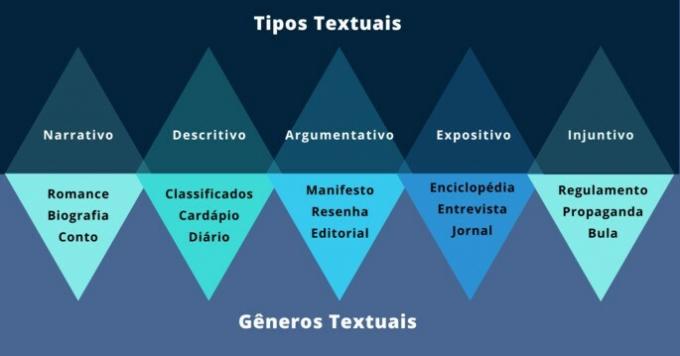O textual genre "report", as the name suggests, is a report, a summary of a given activity and its results.
Reports are widely used in companies, government organizations, academic institutions and in many other contexts. In schools, for example, students often must prepare reports on some educational events, such as science fairs, visits to museums, extracurricular activities, etc.
Main goal of a report is present information in an objective and organized way. In this way, it can be used to assist in decision making, understanding a problem, sharing research results, among others.
As for language, the genre requires the use of standard variety of the language. In other words, it must comply with the cultured norm. Communication, therefore, must value clarity and objectivity, avoiding ambiguities.
How to make a report
Preparing a report involves following a set of steps to ensure that the information is presented in a clear and organized way. Below is a step-by-step guide on how to make a report:
1. Identify the purpose of the report
Before you start writing, it's critical to understand why you are creating the report. What is the main objective? What do you want to achieve with it? This will help direct the content and structure of the report.
2. Information collection
Gather all relevant information for your report. This can include data, research results, reference documents, and any other information needed to support your argument or conclusions.
3. Content organization
Define a structure clear for your report. Typical structure includes:
Cover: Containing the title of the report, the name of the author, the institution where it will be presented, the date and other relevant information.
Summary or Index: A list of report sections with corresponding page numbers.
Introduction: Introduce the topic, the purpose of the report and an overview of what will be discussed.
Development: Divided into sections or chapters, where you present the information in a logical and organized way.
Conclusion: Summarize the main points of the report and present your conclusions.
Recommendations or suggestions (if applicable): If appropriate, offer suggestions or guidance based on the findings.
Bibliographic references: must be presented when requested, to theoretically support the report.
Attachments (if necessary): Include any additional material such as graphs, tables, or supporting documents.
4. Write text
Start writing the report content, keeping it clear and concise. Avoid unnecessary jargon and use language that is appropriate to the standard and accessible to the target audience. Remember to cite your sources when appropriate to ensure the credibility of the report.
5. Visual Elements
If necessary, include graphs, tables, images or other visual elements to illustrate information or data. Make sure these elements are relevant and clearly labeled.
6. Review and edit
After you complete your writing, carefully review the report for grammatical errors, such as spelling, punctuation, and formatting. Make sure the structure is organized logically and all information is correct.
7. Format the report
Apply consistent formatting throughout the report. Use an appropriate font style and text size, set appropriate margins and spacing, and use headers and footers as needed. In Brazil, this formatting standard is defined by ABNT (Brazilian Association of Technical Standards).
know more about ABNT formatting rules.
8. Include a Cover and Table of Contents
Create a cover with the report title, author name, date and other relevant information. Then, generate a table of contents or table of contents that lists all sections of the report with corresponding page numbers.
9. Finalize the Report
After completing all of the previous steps, review the report one more time to ensure everything is in order. Make sure it serves its original purpose and is ready to share or present.
Report example
To illustrate the genre, we created a fictional school report on an extracurricular activity.
Cover
On the cover of the fictitious report, we have aligned all the necessary information in a centralized manner. At the top of the page, we identify the institution where the fictitious school report was presented ("Escola Estadual 'Paulo Freire'"), followed by information about the author ("Student: João Silva/ Grade: 9th Year").
In the center of the page, highlighted in capital letters, is the title work ("REPORT ON PARTICIPATION IN THE SCIENCE CLUB"). Below, we indicate the location of the institution ("Miracema do Norte, Rio de Janeiro") and the date presentation, summarized by year ("2023").

summary
The table of contents, also known as the table of contents, is an important section in many types of documents, including reports. It serves the role of providing an overview of the document's structure and content, allowing readers to quickly locate specific information.
In this example, the expression "summary" is highlighted in capital letters, and centered at the top of the page. Below, we have a list of the topics developed in the fictitious report with the corresponding page numbers. Note that the topics are highlighted from the dotted pagination.
Introduction
The introduction is a fundamental section in any type of written document, be it an essay, a report, an academic article, a book or any other text. Its role is to introduce the reader to the content that will follow and establish the context and objectives of the text. This is what we see in the following example:

Development
The development of a report is the main section of the document, where information is presented, discussed and analyzed in detail. It must follow an organized and logical structure.
The information must be presented sequentially, so that readers can easily follow the reasoning. Dividing the development into sections and subsections is a common practice to organize information clearly. Each section addresses a specific topic and can be broken down into subsections to further detail points.
Conclusion
The conclusion of a report summarizes the main points covered in the document, highlighting the results and recommendations, when applicable.

Report types
Reports can vary in terms of format, structure and purpose, depending on the context in which they are used. Below are the most used types of reports:
Reports Technical: These are detailed reports that describe technical or scientific information. They are often used in fields such as engineering, science and technology to document experiments, research and projects. They generally follow specific formatting standards and include detailed technical information.
Research Reports: Present the results of research studies. They include an introduction, literature review, methodology, results, discussion and conclusions. Research reports are common in academic institutions and in scientific research.
Financial reports: These are documents that present an organization's financial information, such as balance sheets, income statements and financial performance analyses. They are fundamental for making financial decisions in companies and organizations.
Incident or Accident Reports: Used in occupational safety and health environments, these reports document incidents or accidents that occur at a workplace. They generally describe what happened, the causes and the necessary corrective measures.
Trip Reports: These are reports that employees or travelers prepare after a business trip. They include information about expenses, itineraries and activities carried out during the trip.
Performance Assessment Reports: Used in human resources, these reports document the evaluation of employee performance. Include feedback on the skills and competencies of employees.
Marketing Reports: These are reports that analyze marketing strategies and the results obtained. These can include market analysis, advertising campaign data and performance metrics.
See too:
- Textual genres
- Examples of Textual Genres
- Text Meaning
- Text types
- Romance
- Chronicle



